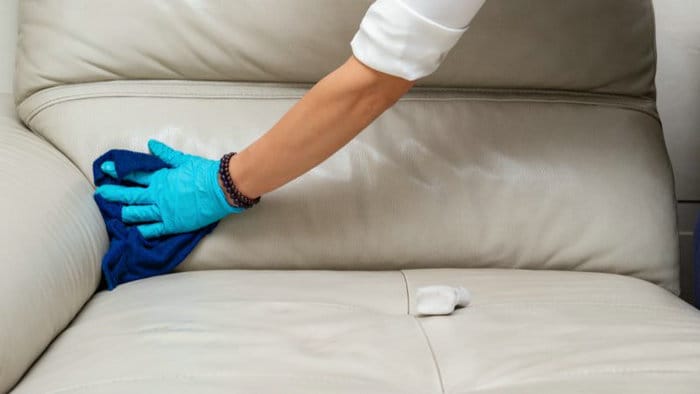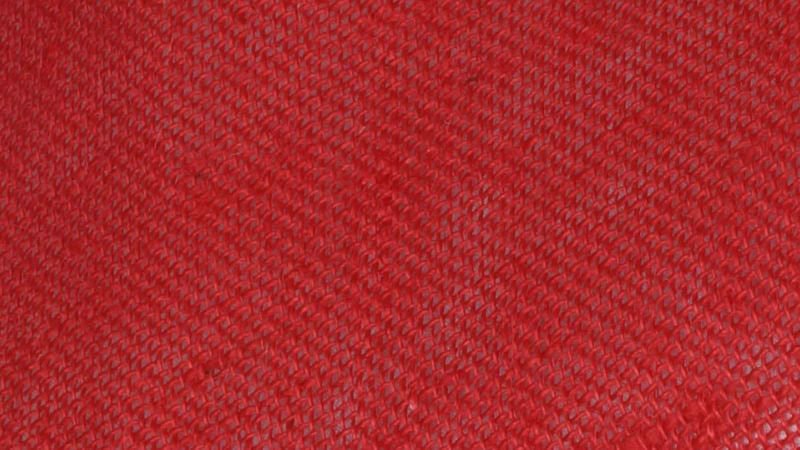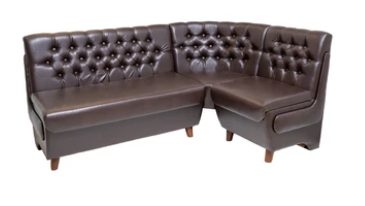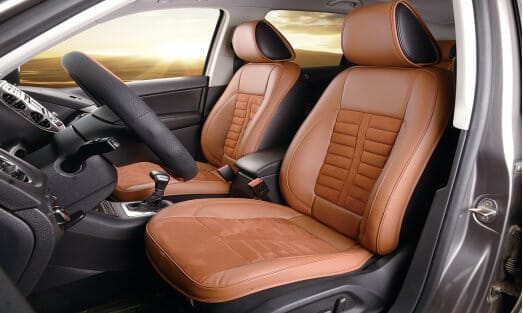When it comes to choosing a new sofa, the big debate often comes down to leather or fabric. Both options have their pros and cons, making the decision a bit tricky. In this article, we’ll explore the types of leather and fabric material and discuss 7 things to consider when choosing a sofa to help you decide which one is right for you.

Types of Leather and Fabric Material
When choosing your perfect sofa, it’s important to know the different sofa materials. This can help you make a better decision based on your needs and preferences.
Different Types of Leather Material
- Full-grain leather
- Top-grain leather
- Corrected-grain leather
- Split-grain leather
- Bonded leather
- Nubuck leather
- Genuine leather
- Aniline leather
- Semi-aniline leather
Different Types of Fabric Material
Sofa fabrics can be broadly categorized into two types: natural and synthetic.
| Natural Fibers | Synthetic Fibers |
| Silk | Nylon |
| Cotton | Rayon |
| Wool | Acrylic |
| Linen | Polyester |
| Suede | Faux Leather |
| Velvet |
7 Things to Consider When Choosing a Sofa

-
Budget
One of the first things to consider when purchasing a sofa is your budget.
Leather Sofa
Leather sofas are often pricey. The cost of leather can vary significantly based on the quality and type of leather used. High-grade sofa leather, such as full-grain or top-grain, tends to be more expensive. While bonded leather or faux leather options can be more affordable
Fabric Sofa
Fabric sofas can also be found at a wide range of price points, making them more accessible for those on a tighter budget.
-
Style
The style of your sofa is another important consideration, as it can significantly impact the overall aesthetic of your living space.
Leather Sofa
Leather sofas often convey a sense of luxury. They are available in various finishes, from matte to high-gloss, and can complement traditional, mid-century, industrial, or minimalist styles. The smooth and sleek surface of leather may add depth and elegance to a room.
But, compared to fabric sofas, leather sofas may have limited upholstery color and pattern options.
Fabric Sofa
Fabric sofas provide a wide range of options. They are available in a variety of colors, prints, and textures, making them versatile and easy to match your home decor.
A fabric sofa is versatile and can complement various interior design styles, including modern, contemporary, Scandinavian, bohemian, and industrial, adding comfort and warmth to any space.
-
Maintenance
Maintenance is another crucial factor when choosing between fabric and leather sofas.
Leather Sofa
Leather is generally easy to clean. It is resistant to stains and spills. A simple wipe-down with a damp cloth is often sufficient to remove the dirt.
Leather is also less prone to absorbing odors, making it a good choice for households. The natural oils in leather can help to create a barrier against odor absorption.
But, leather sofa requires more care and frequent maintenance. It is prone to scratches and scuffs, especially in households with pets and children.
Leather is a natural material that can be affected by extreme temperatures, making it less comfortable in very hot or cold environments. Avoid exposure to the sunlight, as it has the potential to fade and crack.
Fabric Sofa
Fabric sofas can be more challenging to maintain.
Depending on the fabric, stains can be more difficult to remove, and some materials may require special cleaning solutions.
While some fabric sofas come with stain-resistant treatments, they still may not be as forgiving as leather. But now, many fabric sofas are machine washable or come with removable covers, making them easier to clean in certain situations.

-
Longevity
Longevity is a vital consideration when investing in a sofa.
Leather Sofa
Leather sofas are known for their durability and can last for many years with proper care. High-quality leather can withstand wear and tear better than most fabric options, making it a reliable choice for busy households.
Fabric Sofa
Fabric sofas, while often less durable than leather, may show signs of wear more quickly, especially in high-traffic areas.
But, it can still offer a reasonable lifespan depending on the material and construction. High-quality fabrics, such as microfiber or tightly woven materials, can resist wear and last for several years.
-
Comfort
Comfort is paramount when selecting a sofa, as it is often the centerpiece of your living space. Both leather and fabric sofas can provide comfort, but they offer different experiences.
Leather Sofa
Leather sofas tend to have a firmer feel, which can be appealing to some people. They often have a sleek, modern aesthetic and can be quite supportive. However, leather can become hot in warm weather and cold in cooler temperatures, which may affect comfort levels.
Fabric Sofa
Fabric sofas offer a softer and cozier feel. They come in various textures, from plush to woven, allowing for a more personalized comfort experience. Fabric also tends to breathe better, making it a more comfortable option in varying temperatures. However, the level of comfort can vary significantly based on the quality of the fabric and the construction of the sofa itself.
-
Allergies
When buying a sofa, allergy sufferers should take material into account to make the best choice between leather and fabric.
Leather Sofa
Leather is less likely to trap dust mites, pet dander, and pollen due to its smooth, non-porous surface. This makes it easier to maintain a cleaner environment, which can be beneficial for allergy sufferers.
Regular cleaning with a damp cloth can effectively remove dust and allergens from leather surfaces. Unlike fabric, leather doesn’t hold onto particles as much, making it a good option for those who want to minimize allergens in their living space.
Some people may experience allergic reactions to the chemicals used in leather tanning processes. Individuals with sensitive skin might also find certain types of leather irritating.
Fabric Sofa
Fabric sofas tend to attract and hold onto allergens like dust, pet hair, and pollen. This can be problematic for individuals with allergies or respiratory issues.
Fabric is generally hypoallergenic, which can help reduce the presence of allergens. Look for sofas made from synthetic fibers that resist dust and are easier to clean.
Regular vacuuming and occasional deep cleaning are necessary to keep fabric sofas free from allergens. This can be more time-consuming compared to leather.
-
Seasonal Considerations
It’s also important to consider how seasonal changes can affect your comfort and overall experience throughout the year.
Leather Sofa
In hot weather, leather can feel hot and sticky, especially if you’re sitting for long periods. Some people find that leather retains heat, which can be a downside in warm climates.
Leather is often warmer in the winter, providing a cozy feel during colder months. Its ability to retain heat can make it a comfortable option when the temperatures drop.
Fabric Sofa
Fabric sofas tend to be more breathable, which can make them feel cooler during the summer months. This can be especially beneficial in hot climates where comfort is a priority.
Fabric can absorb moisture and may feel cold in the winter initially. Adding throw blankets or cushions can enhance comfort and warmth. Fabric can be more forgiving in terms of temperature fluctuations, making it a versatile choice year-round.
Conclusion
The choice between a leather or fabric sofa is a personal one. There’s no one-size-fits-all answer. Whether you’re drawn to the sleek design of leather or the inviting warmth of fabric, what matters most is that your new sofa feels right for you and enhances the space where you’ll spend countless hours relaxing and socializing.
Frequently Asked Questions
Should I use a conditioner on my leather sofa?
Yes, using a leather conditioner every 6-12 months can help maintain the leather’s suppleness and prevent cracking.
Can I find eco-friendly options in leather and fabric sofas?
Yes, some brands offer eco-friendly faux leather options or sustainably sourced fabrics, making it possible to find environmentally conscious choices in both categories.







